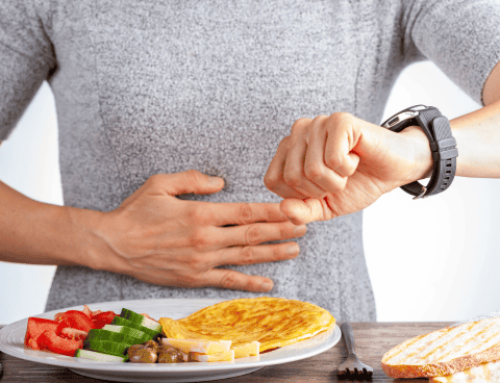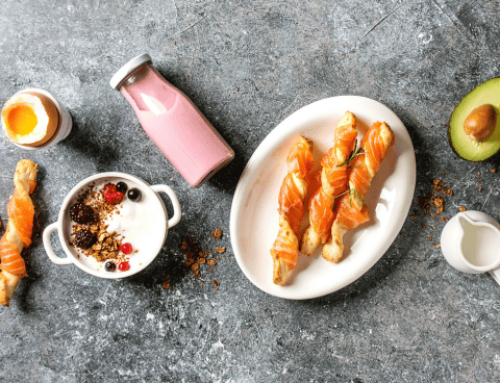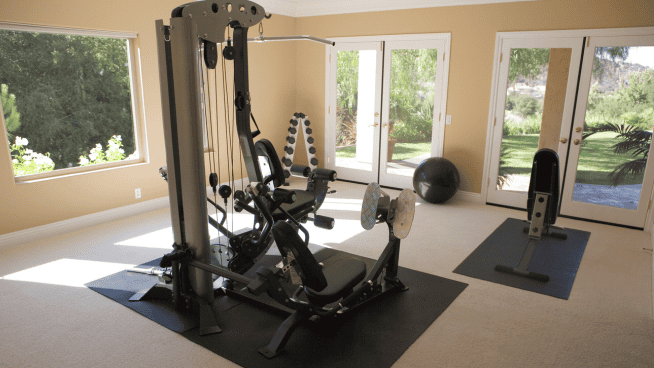Why Nutrition Isn’t About Making the ‘Perfect’ Choice
Eating healthy is hard.
Simple, but hard.
In this day and age, the temptation to eat unhealthily is huge. With so many poor options when it comes to nutrition, how can one rise above it? I call it the Healthy Eating Continuum.
The healthy eating continuum is about looking at the options available to you and making the best choice with what you have.
Foods higher in nutritional value are further to the right, while foods lower in nutritional value are further to the left. For example, a bowl of cereal is likely better than a giant cinnamon bun, and a bowl of oatmeal with fruit is likely better than a bowl of cereal:
Every option you conveniently have access to sits somewhere on the continuum. And even making small tweaks to the same meal will push it to the right or left of the continuum. For example, a small cinnamon bun is further to the right on the continuum than a large cinnamon bun, as is cereal with fresh fruit compared to plain cereal.
The reality is that we almost always have options regarding what to eat. Looking at food on a continuum instead of as a binary “perfect” or “horrible” choice is far more practical and sustainable.
Eating at the cafeteria after practice? Try getting the mashed potatoes instead of the French fries. At the food court? Go for a grilled steak pita instead of the greasy double cheeseburger. See, it’s simple.
Is a grilled steak pita the greatest health food of all time? Not necessarily! But it is further to the right on the continuum of healthy eating than a double cheeseburger.
And say you really, really want that double cheeseburger. OK, well ordering it with an apple instead of French fries or getting a single instead of a double are concrete ways to move it right on the continuum.
I’ve found thinking of food in terms of a continuum not only helps me make healthier choices more frequently, but also inspires me to find ways to make those foods on the far left of the continuum a bit better for me. I’ve also found this to be a helpful way to talk about food with young athletes.
Instead of trying to map out a perfect diet, counting every single calorie, or avoiding going out with your friends because burger joints are the devil, go be social and do the best you can in each scenario.
If you go to McDonald’s and get the chicken breast wrap, that’s a win. If you go to a fancy restaurant (like where your mom and dad go on dates) and get the chicken rice bowl instead of the ribs and fries, that’s also a win.
There is no need to beat yourself up over not eating “perfect,” whatever that means. Just strive to do better than you are right now. As I have been told before, no one ever got shredded from eating one salad, and no one lost their abs from eating one burger. Relax, be human, and do the best you can!
I may sound like I’m making it too simple. Make no mistake: eating this way can still be a challenge.
The hard part comes when you walk into the cafeteria and they’ve just put out a fresh deep-dish pizza. It also comes when you have to get up early for practice and you aren’t feeling hungry at all, so you want to just skip breakfast. Ignoring your first instinct in these type of situations is hard.
No matter how many times I harp on the importance of breakfast, when one of my athletes actually chooses to get up and eat breakfast before their morning lift, I consider it a miracle.
But I’m doing my best to make those miracles more frequent.
For one, I’m trying to get a better, fuller picture of how they actually eat. Food journals or having them take pictures of their meals for a period of time can help you understand where they’re at. It’s hard to make nutrition recommendations if you don’t know what the athlete is currently putting in their mouth.
Once I get a look at what they’re currently eating, I’m looking to help them find ways to move right on the spectrum. Again, it’s not so much about eating perfect, but just getting them in the momentum of eating better.
They currently pound potato chips and pop before bed? How about chocolate milk and nuts?
They get deep-fried sushi three times a week? How about trying non-fried options instead?
They never eat breakfast? How about grabbing a piece of fruit or a slice of toast on their way out the door?
All of these would be a step in the right direction.
Getting them to eat nothing but chicken breast, rice and broccoli is unrealistic.
If we can get them to take a step to the right, that’s a massive win.
Eventually, we can get to these picture-perfect options for developing high-performance athletes, but right now, we just need to get our athletes to stop shoveling gummy candies into their mouths and calling it breakfast.
The last thing to consider is tolerability.
We as coaches may think we know what the perfect pre-game meal or post workout plan is for refueling yourself.
However, what if the athlete can’t stomach asparagus and baked potatoes before a game? What if their budget doesn’t allow them to have fresh fruits and veggies on hand for post-lift snacks?
Look at their scenario and provide real, tangible options for them that they like and can stick with. We always say that an average program done with intensity and effort will get better results than a perfect program not done at all. The same goes for nutrition plans.
It is better to get athletes eating food they enjoy and have access to, than giving them options that their bowels hate or that can only be found at the trendy market on the other side of town.
Bottom line: do the best you can. We are not perfect, nor will we ever be. No sense in beating yourself up for eating a burger, or locking yourself in your room to prevent you from the temptation of eating one. Get in the mindset of looking for ways you can move choices to the right, even if it’s just by a fraction, and you’ll pick up positive momentum.
Photo Credit: SDI Productions/iStock
READ MORE:
RECOMMENDED FOR YOU
Why Nutrition Isn’t About Making the ‘Perfect’ Choice
Eating healthy is hard.
Simple, but hard.
In this day and age, the temptation to eat unhealthily is huge. With so many poor options when it comes to nutrition, how can one rise above it? I call it the Healthy Eating Continuum.
The healthy eating continuum is about looking at the options available to you and making the best choice with what you have.
Foods higher in nutritional value are further to the right, while foods lower in nutritional value are further to the left. For example, a bowl of cereal is likely better than a giant cinnamon bun, and a bowl of oatmeal with fruit is likely better than a bowl of cereal:
Every option you conveniently have access to sits somewhere on the continuum. And even making small tweaks to the same meal will push it to the right or left of the continuum. For example, a small cinnamon bun is further to the right on the continuum than a large cinnamon bun, as is cereal with fresh fruit compared to plain cereal.
The reality is that we almost always have options regarding what to eat. Looking at food on a continuum instead of as a binary “perfect” or “horrible” choice is far more practical and sustainable.
Eating at the cafeteria after practice? Try getting the mashed potatoes instead of the French fries. At the food court? Go for a grilled steak pita instead of the greasy double cheeseburger. See, it’s simple.
Is a grilled steak pita the greatest health food of all time? Not necessarily! But it is further to the right on the continuum of healthy eating than a double cheeseburger.
And say you really, really want that double cheeseburger. OK, well ordering it with an apple instead of French fries or getting a single instead of a double are concrete ways to move it right on the continuum.
I’ve found thinking of food in terms of a continuum not only helps me make healthier choices more frequently, but also inspires me to find ways to make those foods on the far left of the continuum a bit better for me. I’ve also found this to be a helpful way to talk about food with young athletes.
Instead of trying to map out a perfect diet, counting every single calorie, or avoiding going out with your friends because burger joints are the devil, go be social and do the best you can in each scenario.
If you go to McDonald’s and get the chicken breast wrap, that’s a win. If you go to a fancy restaurant (like where your mom and dad go on dates) and get the chicken rice bowl instead of the ribs and fries, that’s also a win.
There is no need to beat yourself up over not eating “perfect,” whatever that means. Just strive to do better than you are right now. As I have been told before, no one ever got shredded from eating one salad, and no one lost their abs from eating one burger. Relax, be human, and do the best you can!
I may sound like I’m making it too simple. Make no mistake: eating this way can still be a challenge.
The hard part comes when you walk into the cafeteria and they’ve just put out a fresh deep-dish pizza. It also comes when you have to get up early for practice and you aren’t feeling hungry at all, so you want to just skip breakfast. Ignoring your first instinct in these type of situations is hard.
No matter how many times I harp on the importance of breakfast, when one of my athletes actually chooses to get up and eat breakfast before their morning lift, I consider it a miracle.
But I’m doing my best to make those miracles more frequent.
For one, I’m trying to get a better, fuller picture of how they actually eat. Food journals or having them take pictures of their meals for a period of time can help you understand where they’re at. It’s hard to make nutrition recommendations if you don’t know what the athlete is currently putting in their mouth.
Once I get a look at what they’re currently eating, I’m looking to help them find ways to move right on the spectrum. Again, it’s not so much about eating perfect, but just getting them in the momentum of eating better.
They currently pound potato chips and pop before bed? How about chocolate milk and nuts?
They get deep-fried sushi three times a week? How about trying non-fried options instead?
They never eat breakfast? How about grabbing a piece of fruit or a slice of toast on their way out the door?
All of these would be a step in the right direction.
Getting them to eat nothing but chicken breast, rice and broccoli is unrealistic.
If we can get them to take a step to the right, that’s a massive win.
Eventually, we can get to these picture-perfect options for developing high-performance athletes, but right now, we just need to get our athletes to stop shoveling gummy candies into their mouths and calling it breakfast.
The last thing to consider is tolerability.
We as coaches may think we know what the perfect pre-game meal or post workout plan is for refueling yourself.
However, what if the athlete can’t stomach asparagus and baked potatoes before a game? What if their budget doesn’t allow them to have fresh fruits and veggies on hand for post-lift snacks?
Look at their scenario and provide real, tangible options for them that they like and can stick with. We always say that an average program done with intensity and effort will get better results than a perfect program not done at all. The same goes for nutrition plans.
It is better to get athletes eating food they enjoy and have access to, than giving them options that their bowels hate or that can only be found at the trendy market on the other side of town.
Bottom line: do the best you can. We are not perfect, nor will we ever be. No sense in beating yourself up for eating a burger, or locking yourself in your room to prevent you from the temptation of eating one. Get in the mindset of looking for ways you can move choices to the right, even if it’s just by a fraction, and you’ll pick up positive momentum.
Photo Credit: SDI Productions/iStock
READ MORE:











